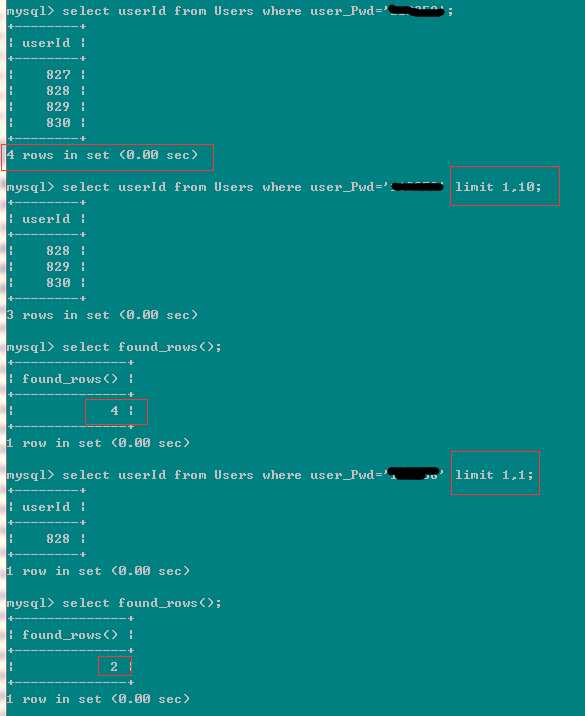标签:
移植sql server 的存储过程到mysql中,遇到了sql server中的:
IF @@ROWCOUNT < 1
对应到mysql中可以使用 FOUND_ROWS() 函数来替换。
1. found_rows() 函数的文档:
http://dev.mysql.com/doc/refman/5.6/en/information-functions.html#function_found-rows
1)found_rows() 的第一种使用情况(带有SQL_CALC_FOUND_ROWS,):也带有
A SELECT statement may include a LIMIT clause to restrict the number of rows the server returns to the client. In some cases, it is desirable to know how many rows the statement would have returned without the LIMIT, but without running the statement again. To obtain this row count, include a SQL_CALC_FOUND_ROWS option in the SELECT statement, and then invoke FOUND_ROWS() afterward:
mysql>SELECT SQL_CALC_FOUND_ROWS * FROM->tbl_nameWHERE id > 100 LIMIT 10;mysql>SELECT FOUND_ROWS();
The second SELECT returns a number indicating how many rows the first SELECT would have returned had it been written without the LIMIT clause.
前面的带有limit的select语句如果加上了 SQL_CALC_FOUND_ROWS,那么接下来执行的 SELECT FOUND_ROWS(); 将返回前面语句不带limit语句返回的行数。
2)found_rows() 的第二种/第三中使用情况(不带有SQL_CALC_FOUND_ROWS):
In the absence of the SQL_CALC_FOUND_ROWS option in the most recent successful SELECT statement, FOUND_ROWS() returns the number of rows in the result set returned by that statement. If the statement includes a LIMIT clause, FOUND_ROWS() returns the number of rows up to the limit. For example, FOUND_ROWS() returns 10 or 60, respectively, if the statement includes LIMIT 10 or LIMIT 50, 10.
The row count available through FOUND_ROWS() is transient and not intended to be available past the statement following the SELECT SQL_CALC_FOUND_ROWS statement. If you need to refer to the value later, save it:
mysql>SELECT SQL_CALC_FOUND_ROWS * FROM ... ;mysql>SET @rows = FOUND_ROWS();
If you are using SELECT SQL_CALC_FOUND_ROWS, MySQL must calculate how many rows are in the full result set. However, this is faster than running the query again without LIMIT, because the result set need not be sent to the client.
1> 第二种使用情况(不带有SQL_CALC_FOUND_ROWS,):也没有带 limit
如果前面的select语句没有带 SQL_CALC_FOUND_ROWS,也没有带 limit ,那么后面的 SELECT FOUND_ROWS(); 返回的结果就是前面的select返回的行数;

2> 第三中使用情况(不带有SQL_CALC_FOUND_ROWS,但是):有带 limit
如果前面的select语句没有带 SQL_CALC_FOUND_ROWS,但是带有 limit,那么后面的 就是limit语句到达的最大的行数,比如:select * from xxx limit 10; 到达的最大的行数为10,所以 found_rows() 返回10;比如 select * from xxx limit 50,10; 它要从第50行开始,再扫描10行,所以到达的最大的行数为60,所以SELECT FOUND_ROWS(); 返回的结果found_rows() 返回60。

这里第一个select found_rows() 返回105,因为他是从偏移100的地方,再扫描5行,所以返回105;但是第二个扫描的结果为空,select found_rows()返回了0!而不是105,因为 where userId=999999的结果为空,所以后面的 limit 100,5根本就没有执行。所以select found_rows()返回了0。
再看一个例子,更深入的理解其中情况下的 found_rows():

上面sql中 user_Pwd=xx 的值都是一样的。可以看到这种情况下的found_rows() 是对的select语句的中间结果,再 limit 时,此时的limit的扫描到的最大的行数。和原始表中的数据的行数,是没有关系的。他是对select的中间结果的limit,然后才得到最后的结果集,再返回。
3)SQL_CALC_FOUND_ROWS and FOUND_ROWS() 适合使用的场景
SQL_CALC_FOUND_ROWS and FOUND_ROWS() can be useful in situations when you want to restrict the number of rows that a query returns, but also determine the number of rows in the full result set without running the query again. An example is a Web script that presents a paged display containing links to the pages that show other sections of a search result. Using FOUND_ROWS() enables you to determine how many other pages are needed for the rest of the result.
1> SQL_CALC_FOUND_ROW + limit + found_rows() 可以使用在分页的场合。
2> 不带SQL_CALC_FOUND_ROW 的 found_rows() 可以使用在存储过程中判断前面的select是否为空:
DELIMITER // DROP PROCEDURE IF EXISTS loginandreg // CREATE PROCEDURE loginandreg( OUT userId BIGINT, IN user_Pwd VARCHAR(32), IN user_MobileCode VARCHAR(16), IN user_RegIP VARCHAR(16) ) BEGIN IF EXISTS(SELECT * FROM Users u WHERE u.user_MobileCode=user_MobileCode) THEN SELECT u.userId INTO userId FROM Users u WHERE u.user_MobileCode=user_MobileCode AND u.user_Pwd=user_Pwd; IF FOUND_ROWS() < 1 THEN SELECT -1 INTO userId; END IF; ELSE INSERT INTO Users(user_Pwd,user_MobileCode,user_Visibility,user_Level,user_RegTime,user_RegIP,user_Collecter,user_Collected) VALUES (user_Pwd,user_MobileCode,6,6,NOW(),user_RegIP,0,0); SELECT LAST_INSERT_ID() INTO userId; END IF; END // DELIMITER ;
上面存储过程中的:
SELECT u.userId INTO userId FROM Users u WHERE u.user_MobileCode=user_MobileCode AND u.user_Pwd=user_Pwd; IF FOUND_ROWS() < 1 THEN SELECT -1 INTO userId; END IF;
就是一个很好的使用的例子。
这种存储过程的场景中就可以使用 mysql 的 FOUND_ROWS() 替换 sql server 存储过程中的 IF @@ROWCOUNT < 1 语句。
标签:
原文地址:http://www.cnblogs.com/digdeep/p/4818660.html